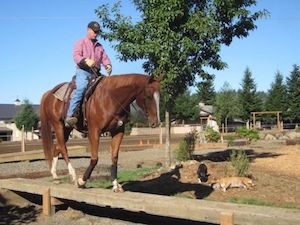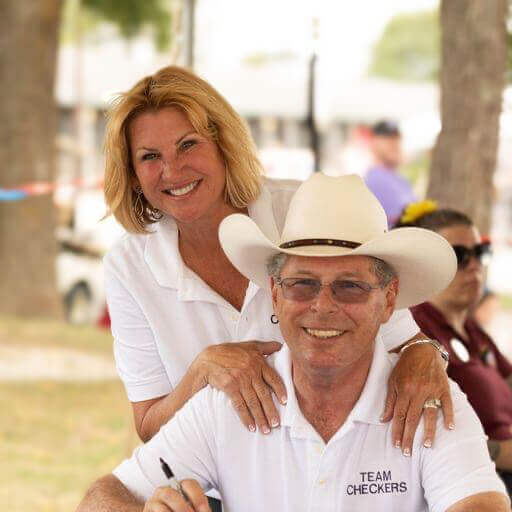An Exercise in Focus
by Mark Bolender

Trail challenge and mountain trail are based on real situations found riding on the trail. Certain obstacles simulate these working conditions.
One important obstacle is the balance beam. It simulates some of the difficult log and bridge crossings required to cross creeks or ravines. It’s a fantastic tool to teach horses to focus, not only on the crossing but on any task at hand such as riding a straight line. The following is a good method to begin training with a balance beam.
First, wrap your horse’s legs to prevent injuries. It’s ideal to have two balance beams to work with; one that’s low to the ground and another that’s more elevated. Master the low balance beam before you graduate to the elevated one. Before starting the training, you must have the horse’s respect and/or a strongly established “Bolender Bubble” in place. If you don’t, the horse will push into your personal space. If this happens, you must correct the behavior before proceeding. If the behavior is not blocked the horse’s instinct will prevent him from trying to please you.
Establishing this bubble is not about domination; it’s about being safe and a teacher of the horse. It does not mean that all your troubles are over, but when you trigger the instinct to please the training will be easier. The instinct to please overrides the instinct to avoid the unknown in a horse. The balance beam is an unknown item so the horse must be very confident in your leadership.
Now drive the horse from the ground to the low balance beam and have it inspect the obstacle. Do not force the horse, but give it all the time it needs to inspect, smell, chew or even paw the beam if it desires. Being curious creatures, most horses will place one foot on the balance beam and then take it off, then repeat the process.
You should apply gentle pressure to the horse until it moves forward and puts its foot back on the balance beam. Immediately stop all movement to take the pressure off, and let the horse think it through. This method will appear slow at first, but will pay dividends in the end because it builds boldness and confidence better than pushing the horse and forcing it to comply.
As the horse steps up with both feet, make sure your lead rope is loose. If the horse doesn’t stand on the balance beam on a loose lead rope then, in its mind, the effort never happened. So you must resist hanging onto the lead rope. Depending on the horse, placing both feet on the beam and then removing them is normal, and this may go on a number of times.
Once the horse has both feet on the beam and appears quiet, it’s time to apply pressure and ask it to step up with its hind feet. Once again, when the horse steps up with all four feet, stop all pressure. Allow it to stand on a loose lead rope before moving on. At this point you will be facing the horse.
Remember that in the horse’s mind, the less you move your feet, the more authority you have. Stay quiet, calm, and show no emotions. The horse will reward you by taking several baby steps. When the horse has mastered the low balance beam from the ground, then you can move to the elevated balance beam. The steps are the same—drive the horse to the obstacle and allow it time to think it through.
When the horse is comfortable walking across the elevated beam then it’s time to ride. Some horses act as if they’ve never seen the low balance beam once you’re mounted up. However, the steps are the same as presenting the balance beam from the ground. Have the horse face it straight on and allow it time to think it through. The horse will probably put one foot up at first, and then back off. Allow this to occur, but be persistent in asking the horse to go forward. Once it steps up on the balance beam, allow it the privilege of smelling, chewing or pawing the beam.
Most horses will simply step off at this time. Do not turn the horse around. Instead, back up the horse and have it step up on the beam again. Show no emotion or impatience, and do not become aggressive; that will defeat the purpose of building boldness and confidence in the horse.
Once the horse is willing to step up quietly and walk on the beam, simply look forward and walk. At this point your job is done, and the horse should walk quietly and confidently, with a focused expression on both the low and elevated balance beam.
Happy Trails and Bolender Blessings!
Originally Published August 2017 Issue

Mark and Lee Bolender own and operate Bolender Horse Park in Washington State, which houses the finest Mountain Trail course in the world. They are the founders of the International Mountain Trail Challenge Association (IMTCA) and travel worldwide as clinicians and ambassadors of Mountain Trail. Bolender Horse Park offers riders of all skill levels and disciplines a fun and challenging trail riding adventure.
Mark has designed and built Mountain Trail courses in the USA, Canada, Australia, and Europe—with many more in development. Mark uses his artistic, landscaping, horse training, and construction skills to build these courses (NW Steel Design LLC www.nwsteeldesign.com).
Mark is the author of Bolender’s Guide to Mastering Mountain and Extreme Trail Riding. Visit www.bolenderhorsepark.com to learn more.






